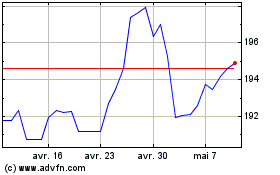Pound Slides On Weak U.K. Economic Data
11 Mai 2017 - 8:06AM
RTTF2
The British pound weakened against the other major currencies in
the early European session on Thursday, following the releases of
weak industrial production numbers and widening trade balance.
Data from the Office for National Statistics showed that U.K.
industrial production declined for the third consecutive month in
March. Industrial output fell 0.5 percent month-on-month, following
a 0.8 percent drop in February. Production was expected to decrease
0.4 percent. On a yearly basis, growth in industrial production
slowed more-than-expected to 1.4 percent in March from 2.5 percent
in February. The expected pace of growth was 1.9 percent.
Likewise, manufacturing output slid 0.6 percent after easing 0.3
percent in the previous month. Economists had forecast a moderate
0.2 percent fall for March. Manufacturing output growth came in at
2.3 percent versus 3 percent in February. Economists had forecast
the rate to remain unchanged at 3 percent.
Also, data from the ONS showed that the U.K. visible trade
deficit widened in March.The visible trade deficit increased to GBP
13.44 billion from GBP 11.44 billion in February. The expected
level was GBP 11.6 billion.
On a monthly basis, export and import prices increased by 1.5
percent and 1.4 percent respectively.
The total trade deficit widened to GBP 4.9 billion from GBP 2.65
billion in the prior month. The visible trade deficit widened to
GBP 36.87 billion in the first quarter from GBP 31.64 billion in
the prior quarter.
At the same tine, the ONS said the U.K. construction output
declined for the third straight month in March, defying economists'
expectations for an increase. Construction output fell 0.7 percent
month-over-month in March, slower than the 1.3 percent decreased in
February. In contrast, economists had expected a 0.4 percent rise
for the month.
On a yearly basis, construction output grew at a faster pace of
2.4 percent in March, following a 0.9 percent gain a month ago.
However, that was below the 2.9 percent rise expected by
economists.
In the Asian trading today, the pound held steady against the
other major currencies.
In the European trading, the pound fell to 2-day lows of 1.2904
against the U.S. dollar, 1.2999 against the Swiss franc and 0.8428
against the euro, from early highs of 1.2948, 1.3064 and 0.8395,
respectively. If the pound extends its downtrend, it is likely to
find support around 1.27 against the greenback, 1.27 against the
franc and 0.85 against the euro.
Against the yen, the pound dropped to 147.32 from an early high
of 147.95. The pound may test support near the 145.00 region.
Looking ahead, at 6:25 am ET, Federal Reserve Bank of New York
President William Dudley is expected to deliver a speech titled
"Benefits and Challenges of Globalization," in Mumbai.
The Bank of England will announce its interest rate decision at
7:00 am ET. Economists expect the bank to retain interest rates
unchanged at 0.25 percent and asset purchase target at GBP 435
billion.
As seen at the March meeting, BOE Governor Kristin Forbes is
expected to call for a rate hike citing rising inflation.
In its quarterly Inflation Report, the bank is also set to cut
its growth outlook as consumers curb their spending amid higher
prices.
In the New York session, Canada new housing price index for
March, U.S. PPI for April and U.S. weekly jobless claims for the
week ended May 6, are set to be published.
At 11:30 am ET, IMF Chief Economist Maurice Obstfeld will
deliver a speech at Geneva Graduate Institute, in Geneva,
Switzerland.
At 11:35 am ET, President of the European Central Bank Mario
Draghi and Member of the ECB Executive Board Benoit Coeure
participate in G7 Finance Ministers and Central Bank Governors
meeting, in Bari, Italy.
Sterling vs Yen (FX:GBPJPY)
Graphique Historique de la Devise
De Mar 2024 à Avr 2024

Sterling vs Yen (FX:GBPJPY)
Graphique Historique de la Devise
De Avr 2023 à Avr 2024
